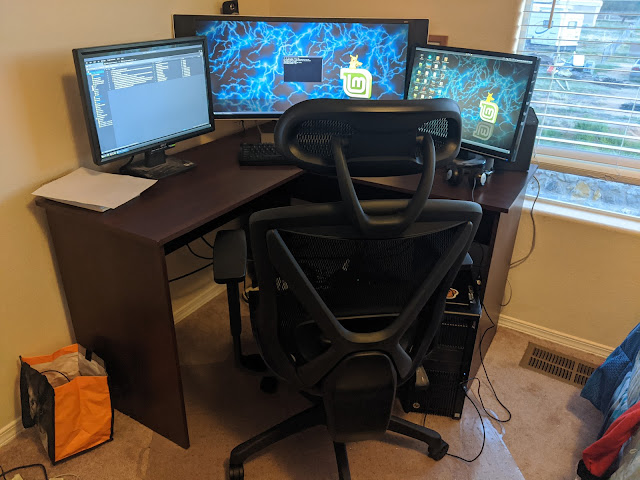March-July book: Designing UX: Forms. Plus tales of pandemic work-from-home madness.
Anyway, I officially started working from home March 18. By that time NMSU was no longer "allowing" us to work from home by choice, but instead sending everyone possible home. In less than a week we had to move nearly the entire workforce to remote work. It was mass chaos then and for several more weeks, although us programmers mostly watched in awe at the kick-ass job our fellow IT people were doing, while trying to figure out how best to communicate and keep each other in the loop. We are a highly collaborative team, so it was very rough going at first. There was a LOT of whining in the dev Teams channel about how much we hated working from home, I'm not gonna lie.
But months have passed, we have mostly figured things out, Teams is the new center of our virtual work life, NMSU has said we can keep working from home even after the pandemic (!), and I have been trying to get back into my groove. Thus, finally finishing this very excellent book.
I had a sort of epiphany awhile back, that for the sorts of apps we create, business apps used by our fellow NMDA employees, the single most important and most used aspects of our user interfaces are essentially forms to record all that business data. I had been researching UX and UI design for awhile, but most of the content I saw practically ignored forms. I still see shockingly little about form design, considering how incredibly important forms are to e-commerce and all sorts of other sites. So I started searching specifically for form design info, and came upon this book and a few others, although again, not that many compared to other UX topics, which probably explains a lot about why there are so many crappily designed forms out there.
Designing UX: Forms by Jessica Enders was published in 2016, but it's still extremely relevant to creating forms on the web today. It's also one of the more recent books I was able to find, which is why I decided to start here. It covers the 3 main aspects of form design: words, layout, and flow, which should be considered and worked on in that order. The book gives great actionable tips to analyze and improve most aspects of a form. I suppose a lot of it seems very common-sense. Use simple language, be as precise and unambiguous in your questions as possible, etc. The primary point through everything is to make every aspect of the form as clear as possible and leave no room for interpretation, so that you get the information you're actually looking for. However, again considering the absolute mountain of poorly designed forms out there, these "common sense" things are ignored far too often. I appreciated the way the book laid the whole form design procedure out, step by step, so that you can easily follow the process and make sure you're guarding against all the most common form-related problems.
I had to laugh at one of the first rules for form design presented in the book: don't copy other people's forms. Because the chance is so high that the form you pick has some serious usability issues, I wholeheartedly endorse this view. A few points from the book surprised me quite a bit, such as an entire section cautioning about dropdown menus. We use these all over the place, for one thing because Rails makes it so easy to implement them compared to the primary alternatives, which are checkboxes, radio buttons, or a text box with autocomplete. But searching around I found quite a lot of criticism of dropdowns from other UX experts, as well, so I am having to rethink our use of them. Throughout the book I often recognized the same sorts of problems we've had in our actual, live apps in the examples given, so overall this is going to be extremely helpful. I've already started going over the biggest points with the other dev, and I'm also hoping to use some of the info about deciding what needs to be collected (and recognizing that the more info you collect, the higher the chance for errors) to create a document we can give to our co-workers before we start creating an app for them. More thought on that before we start could definitely ease some of our pains.
All in all I give this book 5 stars and highly recommend it for anyone who creates a lot of forms as part of their apps. It's a quick read with specific tips on improving your forms, so it's well worth the investment of time. Jessica Ender's old blog, Formulate, has some excerpts from the book and plenty of great advice, if you want a taste before going all in.
For August I am planning to go for something a bit more fun (form design is super important and all, but it doesn't exactly get me excited about my day, if you know what I mean) and go for the book Blockchain Basics by Daniel Drescher. Blockchain tech is making its way into agriculture and some of the higher ups at work have been making noises about it for awhile, so my boss picked this book up awhile ago. When he found out I was interested he gave the book to me: one less thing for him to worry about! I had signed up for a blockchain course at NMSU in the spring which was unfortunately cancelled due to low enrollment, so I am pretty excited to finally be getting into this.




Comments
Post a Comment